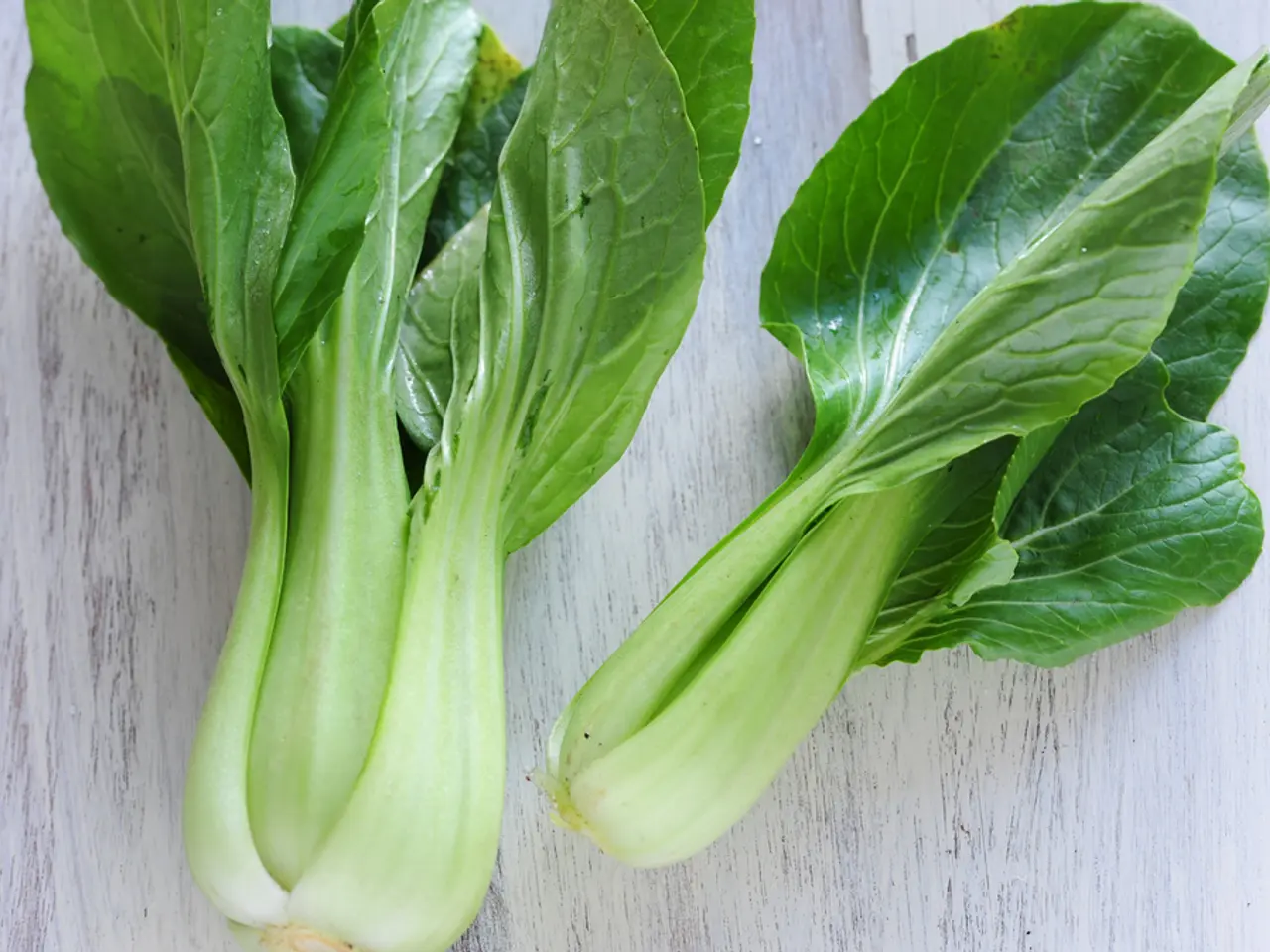Diabetes-Friendly Vegetables: Options, Advantages, and Meal Suggestions
People with type 2 diabetes can reap numerous benefits from incorporating certain vegetables into their diet. These vegetables are not only high in fibre but also have a low glycemic index (GI) and are rich in antioxidants, making them an excellent choice for managing blood sugar levels.
Some nitrate-rich vegetables that fall into this category include spinach, lettuce, radishes, fennel, rocket, Chinese cabbage, and parsley. However, it's important to note that while vegetables like potatoes should be consumed in moderation due to their higher carbohydrate content, they are not necessarily off-limits for people with diabetes. Instead, it's crucial to work with a doctor or registered dietitian to create a food plan that suits individual needs.
The glycemic index rates foods based on how quickly they raise blood glucose levels, with pure glucose rated as 100. Foods that raise blood glucose levels more slowly are rated lower on the scale. For instance, sweet potatoes and winter squash also have low GI values, making them suitable choices.
Vegetables such as broccoli, leafy greens (spinach, kale, romaine), bell peppers, cauliflower, green beans, zucchini, cucumbers, and beans stand out as ideal vegetable choices that are high in fibre, low GI, and antioxidant-rich. These vegetables help with slower blood sugar absorption due to high fibre, lower the glycemic response, and provide antioxidants that protect against inflammation and oxidative stress, common in diabetes.
Broccoli, for example, is among the top high-fibre vegetables and is low in carbohydrates. It helps regulate blood sugar, supports a healthy gut microbiome, and is rich in antioxidants that combat oxidative stress linked to diabetes complications. Leafy greens like spinach, kale, and romaine are non-starchy, low-GI vegetables packed with fibre and antioxidants such as vitamin C and polyphenols, which help reduce inflammation and improve glycemic control.
Bell peppers, cauliflower, green beans, zucchini, and cucumbers also offer good fibre content, low GI, and antioxidant properties, helping modulate blood sugar levels effectively. Additionally, beans (legumes) are noted for their very high fibre content and low GI, beneficial for blood sugar control in type 2 diabetes.
When adding high-fibre foods to the diet, it's essential to introduce them gradually to prevent abdominal discomfort. Raw vegetables generally have more fibre than cooked, ground, or otherwise processed vegetables. Leaving the peel on vegetables when possible can also boost the fibre content.
In terms of preparation, it's best to boil, bake, or grill vegetables rather than frying them to reduce calories and fat intake. Drizzling vegetables with lemon juice or trying a vinegar pepper sauce can add flavour without increasing calories. Opting for fresh foods where possible when buying vegetables is also advisable.
Swapping sweetened juices for vegetable juices or vegetable smoothies is another healthy choice. Carrots are a suitable choice instead of chips as snacks or with dips, but it's important to note that carrots have a high GI value. Draining the liquid from canned vegetables before use can help reduce the sodium content.
Lastly, it's essential to remember that while vegetables can play a valuable dietary role for people with type 2 diabetes, they do not lower blood sugar. Consuming half a plate of low to medium GI vegetables can help someone feel full and reduce the risk of a glucose spike. Eating a variety of vegetables can help those with diabetes stay healthy while enjoying a range of meals.
For more information on meal plans for people with type 2 diabetes, consult a healthcare professional who can provide a bespoke diabetes meal plan to ensure that a person consumes the nutrients they need in suitable proportions.
- Incorporating certain vegetables into a diet can benefit individuals with psoriatic arthritis, as they are rich in fiber and antioxidants.
- Spinach, lettuce, and radishes are examples of nitrate-rich vegetables that are beneficial for those with diabetes, although potatoes should be consumed in moderation due to their higher carbohydrate content.
- Sweet potatoes and winter squash also have low GI values, making them suitable choices for individuals with chronic kidney disease.
- Broccoli, with its high fiber content and low carbohydrates, helps regulate blood sugar in people with asthma and COPD.
- Green leafy vegetables like spinach, kale, and romaine are rich in antioxidants and help reduce inflammation and improve glycemic control for individuals with ulcerative colitis.
- Bell peppers, cauliflower, green beans, zucchini, and cucumbers offer good fiber and antioxidant properties for managing blood sugar levels in those with respiratory conditions.
- Beans (legumes) are high in fiber and low GI, beneficial for blood sugar control in individuals with type-2 diabetes and Alzheimer's.
- Gradually introducing high-fibre foods into one's diet can help avoid abdominal discomfort in individuals with eye health issues.
- Leaving the peel on vegetables can boost their fiber content, benefiting individuals with hearing problems.
- Boiling, baking, or grilling vegetables instead of frying them is advisable for individuals with heart and cardiovascular health concerns.
- Flavoring vegetables with lemon juice or vinegar pepper sauce is a low-calorie alternative for those focusing on health and wellness.
- Fresh vegetables are preferable for individuals aiming for fitness and exercise, as they are less processed and retain more nutrients.
- Swapping sweetened drinks for vegetable juices or smoothies is a healthier choice for people dealing with skin conditions like psoriasis.
- Carrots are a suitable snack option for people seeking to maintain a healthy lifestyle.
- Draining the liquid from canned vegetables can help reduce sodium intake for individuals with high blood pressure or hypertension.
- Consuming a variety of vegetables is crucial for maintaining overall health and improving eye health in senior citizens on Medicare.
- CBD oil, when used correctly, can complement therapies and treatments for people with chronic diseases.
- Skin-care products containing antioxidant-rich vegetables may help reduce the appearance of skin aging for people with lifestyle challenges.
- Aq (aloe vera juice) can help promote healthy digestion and support skincare and eye health for those living with multiple medical conditions.
- When it comes to outdoor living, gardening can provide a source of healthy, fiber-rich vegetables for people dealing with depression and anxiety.
- Cooking with a focus on global cuisines can help individuals with mental health issues discover new, nutritious options.
- Home-and-garden projects can provide a sense of accomplishment and improve overall well-being for people with obesity.
- Eating more fiber-rich vegetables is beneficial for maintaining cardiovascular health and reducing the risk of colon cancer.
- Home-improvement projects involving the use of sustainable and eco-friendly materials can contribute to supporting healthy-cooking practices for individuals with chronic kidney disease.
- Love and dating can be made more enjoyable by sharing new, creative, and healthy recipes with a partner.
- Teaching family members about the benefits of different vegetables can lead to improved family dynamics and overall health.
- Pets can benefit from a diet rich in vegetables, helping with the digestion and overall health of our furry friends.
- Deals and discounts on organic and locally-sourced vegetables can help people with a tight budget maintain a balanced, nutritious diet.
- Travel can provide the opportunity to experience unique culinary traditions and enjoy healthy, flavorful dishes worldwide.
- Electric vehicles are eco-friendly modes of transportation for people who are environmentally conscious and want to maintain good cardiovascular health.
- Adventure travel offers the chance to explore new destinations, learn about local cultures, and discover regional cuisines for a holistic approach to travel and health.




